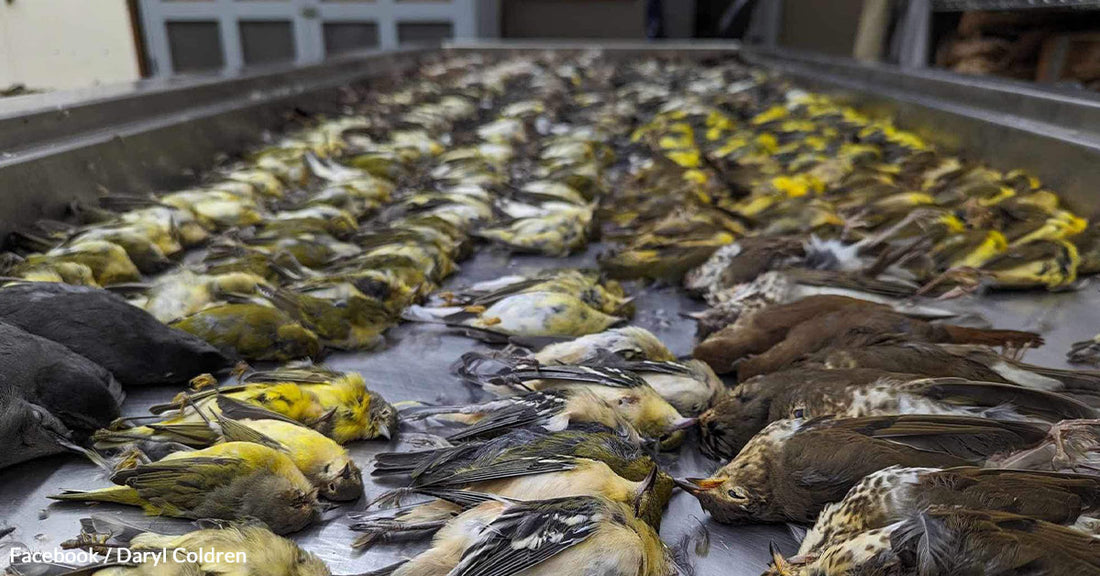Nearly a Thousand Birds Killed Overnight In Chicago — By A Building
Matthew Russell
In just a single night, in the heart of Chicago, the lives of over a thousand migrating birds were lost as they collided with the McCormick Place Lakeside Center, a large convention center situated along the shores of Lake Michigan in Chicago.
This significant loss was attributed to a combination of factors, CNN reports, including the ongoing migration season, adverse weather conditions, and a lack of bird-friendly building features.
 Photo: Facebook / Daryl Coldren
Photo: Facebook / Daryl ColdrenHundreds of birds were killed after flying into a single building in Chicago.
Volunteers and scientists raced to collect these fallen birds, which were discovered in alarming numbers.
"It was overwhelming and tragic to see this many birds," Annette Prince, director of Chicago Bird Collision Monitors, told WXII. "I went to a building where, when I walked up to the building, it was like there was just a carpet of dead and dying and injured birds."
 Photo: Facebook / Daryl Coldren
Photo: Facebook / Daryl ColdrenAn estimated 600 million birds die each year due to building collisions in the United States.
A Confluence of Factors
Migratory birds are particularly vulnerable during migration seasons, such as the fall, Audubon reports, as they undertake long journeys across vast distances. In this incident, several factors came together to create a perfect storm for bird collisions.
- High Volume of Migratory Birds: On that fateful night, an unusually high volume of birds was set to migrate south for the winter, eagerly awaiting the right winds to assist their journey, CNN reports. This led to a sudden surge in bird activity.
- Adverse Weather Conditions: Foggy and low cloud conditions posed an additional challenge, disorienting birds as they flew at lower altitudes, reported WLWT. The reduced visibility brought them closer to the treacherous urban landscape.
- Avian Confusion: Lights from buildings are a major attraction for birds, often leading to fatal collisions, reports KCRA. McCormick Place, being one of the first buildings birds encounter along Lake Michigan, became a deadly trap for these migratory creatures.
- Daytime Collisions: Alarmingly, the bird collisions didn't cease with the arrival of daylight. This highlights the risk that large panels of clear glass pose to birds, as they mistake them for open spaces, Audubon reports. Many of the birds involved were young and inexperienced in navigating urban areas.
 Photo: Facebook / Daryl Coldren
Photo: Facebook / Daryl ColdrenFactors like high bird volumes, adverse weather, and avian confusion contribute to collisions.
Douglas Stotz, a conservation ecologist with the Field Museum, remarked that the evening of the incident was the most significant migration event Chicago had witnessed in a century.
Typically, between 1,000 and 2,000 birds lose their lives each year in collisions with McCormick Place, NPR reports.
 Photo: Twitter / McCormick Place
Photo: Twitter / McCormick Place
Andrew Farnsworth, an ornithologist at Cornell University, told CNN that the number of birds killed in that single night equaled what is typically recorded in a year.
It’s “a very rare thing and a pretty unfortunate thing,” he said.
 Photo: McCormick lakeside center (1333263743), Wikimedia Commons / Rob Jacob, License: CC BY-SA 2.0 DEED
Photo: McCormick lakeside center (1333263743), Wikimedia Commons / Rob Jacob, License: CC BY-SA 2.0 DEEDThe McCormick Place Lakeside Center in Chicago.
A Persistent Problem
This tragic incident shines a light on a broader issue. A 2019 study from Cornell University's Lab of Ornithology estimated that approximately 600 million birds die in building collisions in the United States every year. Chicago, alongside Houston and Dallas, ranks among the most dangerous cities for birds during both the fall and spring migration seasons, reports the Cornell Chronicle.
Learn more in the video below.
https://youtu.be/jEwU6FQeu5I?si=zqjkUG-a-hPVobxB
Mitigating the Threat
While the problem is significant, there are viable solutions to prevent bird collisions. Two key interventions hold the potential to reduce the number of avian deaths significantly:
- Bird-Friendly Glass: Incorporating bird-friendly glass with patterns or fritting that reduces reflectivity can make buildings more visible to birds. This can be a crucial measure in new construction projects, while existing structures can retrofit windows with decals to enhance visibility.
- Reducing Light Pollution: Turning off nonessential lights, especially during peak migratory times, can save lives and contribute to energy conservation. Programs like Chicago's "Lights Out" have encouraged tall buildings to switch off lights after 11 p.m. during migration seasons.
This incident serves as a stark reminder of the responsibility we bear in safeguarding migratory birds during their arduous journeys. These birds play a critical role in maintaining ecological balance and are invaluable to our environment.
It's within our power to change the narrative and give these remarkable migratory birds a fighting chance to thrive in a world shared by humans. The well-being of migratory birds is a shared responsibility, and it's high time we embrace it wholeheartedly.
Click below and take action for birds.

